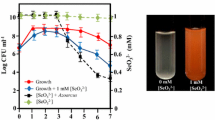Abstract
Plant-associated nitrogen-fixing soil bacteria Azospirillum brasilense were shown to reduce the gold of chloroauric acid to elemental gold, resulting in formation of gold nanoparticles. Extracellular phenoloxidizing enzymes (laccases and Mn peroxidases) were shown to participate in reduction of Au+3 (HAuCl4) to Au0. Transmission electron microscopy revealed accumulation of colloidal gold nanoparticles of diverse shape in the culture liquid of A. brasilense strains Sp245 and Sp7. The size of the electron-dense nanospheres was 5 to 50 nm, and the size of nanoprisms varied from 5 to 300 nm. The tentative mechanism responsible for formation of gold nanoparticles is discussed.
Similar content being viewed by others
References
Dykman, L.A., Bogatyrev, V.A., Shchegolev, S.Yu., and Khlebtsov, N.G., Zolotye nanochastitsy: Sintez, svoistva, biomeditsinskoe primenenie (Golden Nanoparticles: Synthesis, Properties, and Medical Application), Moscow: Nauka, 2008.
Narayanan, K.B. and Sakthivel, N., Biological synthesis of metal nanoparticles by microbes, Adv. Colloid Interface Sci., 2010, vol. 156, pp. 1–13.
Nair, B. and Pradeep, T., Coalescence of nanoclusters and formation of submicron crystallites assisted by Lactobacillus strains, Cryst. Growth Design, 2002, vol. 2, pp. 293–298.
He, S., Guo, Z., Zhang, Y., Zhang, S., Wang, J., and Gu, N., Biosynthesis of gold nanoparticles using the bacteria Rhodopseudomonas capsulate, Mater. Let., 2007, vol. 61, pp. 3984–3987.
Husseiny, M.I., Abd El-Aziz, M., Badr, Y., and Mahmoud, M.A., Biosynthesis of gold nanoparticles using Pseudomonas aeruginosa, Spectrochim. Acta, 2007, vol. 67, pp. 1003–1006.
Konishi, Y., Ohno, K., Saitoh, N., Nomura, T., and Nagamine, S., Microbial synthesis of gold nanoparticles by metal reducing bacterium, Trans. Mater. Res. Soc. Jpn., 2004, vol. 29, pp. 2341–2343.
Nangia, Y., Wangoo, N., Goyal, N., Shekhawat, G., and Suri, C.R., A novel bacterial isolate Stenotrophomonas maltophilia as living factory for synthesis of gold nanoparticles, Microb. Cell Appl. Phys. Lett., 2009, vol. 94, no. 23, pp. 1–3.
Sanghi, R., Verma, P., and Puri, S., Enzymatic formation of gold nanoparticles using Phanerochaete chrysosporium, Adv. Chem. Eng. Sci., 2011, vol. 1, pp. 154–162.
Sadasivan, L. and Neyra, C.A., Flocculation in Azospirillum brasilense and Azospirillum lipoferum: exopolysaccharides and cyst formation, J. Bacteriol., 1985, vol. 163, no. 2, pp. 716–723.
Paszczynski, A., Crawford, R., and Huynh, V.B., Manganese peroxidase of Phanerochaete chrysosporium: purification, Methods Enzymol., 1988, vol. 161, pp. 264–270.
Slomczynski, D., Nakas, J.P., and Tanenbaum, S.W., Production and characterization of laccase from Botrytis cinerea 61–34, Appl. Environ. Microbiol., 1995, vol. 61, pp. 907–912.
Novakovskii, M.E., Drozhdenyuk, A.P., Epshtein, T.V., Dubovskaya, L.V., Khalimonchik, S.V., Fil’chenkov, N.A., Vashkevich, I.I., and Sviridov, O.V., New non-chromatographic method for streptavidin isolation from the culture liquid of Streptomyces avidinii: Comparison with affinity chromatography on iminobiotinsepharose, Biotekhnologiya, 2006, vol. 42, no. 1, pp. 68–75.
Laemmly, U.K., Cleavage of structural proteins during the assembly of the head of bacteriophage T4, Nature, 1970, vol. 227, pp. 680–685.
Tandler, B., Improved uranyl acetate staining for electron microscopy, J. Electron Microsc. Tech., 1990, vol. 1, pp. 81–82.
Philip, D., Biosynthesis of Au, Ag and Au-Ag nanoparticles using edible mushroom extract, Spectrochim. Acta A. Mol. Biomol. Spectrosc., 2009, vol. 73, no. 2, pp. 374–381.
Kreibig, U. and Vollmer, M., Optical Properties of Metal Clusters, Berlin: Springer, 1995.
Tikariha, S., Singh, S., Banerjee, S., and Vidyarthi, A.S., Biosyntesis of gold nanoparticles, scope and application: a review, IJPSR, 2012, vol. 3, no. 6, pp. 1603–1615.
Ramezani, F., Ramezani, M., and Talebi, S., Mechanistic aspects of biosynthesis of nanoparticles by several microbes, Nanocon, 2010, vol. 10, pp. 12–14.
Nikitina, V.E., Vetchinkina, E.P., Ponomareva, E.G., and Gogoleva, Yu.V., Phenol oxidase activity in bacteria of the genus Azospirillum, Microbiology (Moscow), 2010, vol. 79, pp. 327–333.
Nikitina, V.E., Alen’kina, S.A., Ital’yanskaya, Yu.V., and Ponomareva, E.G., Purification and comparative analysis of cell surface lectins from hemagglutinationinducing and inactive Azospirillum cells, Biochemistry (Moscow), 1994, vol. 59, no. 5, pp. 479–482.
Du, L., Jiang, H., Liu, X., and Wang, E., Biosynthesis of gold nanoparticles assisted by Escherichia coli DH5α and its application on direct electrochemistry of hemoglobin, Electrochem. Commun., 2007, vol. 9, no. 5, pp. 1165–1170.
He, S., Guo, Z., Zhang, Y., Zhirui, G., and Ning, G., Biological synthesis of gold nanowires using extract of Rhodopseudomonas capsulate, Biotechnol. Prog., 2008, vol. 24, pp. 476–480.
Beveridge, T.J., Hughes, M.N., Lee, H., Leung, K.T., Poole, R.K., and Savvaidis, I., Metal-microbe interactions: contemporary approaches, Adv. Microb. Physiol., 1997, vol. 38, pp. 177–243.
Feng, Y., Yu, Y., Wang, Y., and Lin, X., Biosorption and bioreduction of trivalent aurum by photosynthetic bacteria Rhodobacter capsulatus, Curr. Microbiol., 2007, vol. 55, pp. 402–408.
Mino, Y., Wariishi, H., Blackburn, N.J., Loerh, T.M., and Gold, M.H., Spectral characterization of manganese peroxidase, an extracellular heme enzyme from the lignin-degrading basidiomycete, Phanerochaete chrysosporium, J. Biol. Chem., 1988, vol. 263, pp. 7029–7036.
Lisov, A.V., Leont’evskii, A.A., and Golovleva, L.A., Hybrid Mn-peroxidase from the ligninolytic fungus Panus tigrinus 8/18. Isolation, substrate specificity, and catalytic cycle, Biochemistry (Moscow), 2003, vol. 68, no. 9, pp. 1027–1036.
Ruiz-Duenas, F.J. and Martinez, A.T., Microbial degradation of lignin: how a bulky recalcitrant polymer is efficiently recycled in nature and how we can take advantage of this, Microbial Biotechnol., 2009, vol. 2, no. 2, pp. 164–177.
Pestovskii, Yu.S., Growth pattern of gold nanoparticles immobilized on mica surface during reduction of chloroauric acid with hydrogen peroxide, Rossiiskie Nanotekhnologii, 2011, vol. 6, no. 3, pp. 46–50.
Author information
Authors and Affiliations
Corresponding author
Additional information
Original Russian Text © M.A. Kupryashina, E.P. Vetchinkina, A.M. Burov, E.G. Ponomareva, V.E. Nikitina, 2014, published in Mikrobiologiya, 2014, Vol. 83, No. 1, pp. 41–48.
Rights and permissions
About this article
Cite this article
Kupryashina, M.A., Vetchinkina, E.P., Burov, A.M. et al. Biosynthesis of gold nanoparticles by Azospirillum brasilense . Microbiology 82, 833–840 (2013). https://doi.org/10.1134/S002626171401007X
Received:
Published:
Issue Date:
DOI: https://doi.org/10.1134/S002626171401007X




